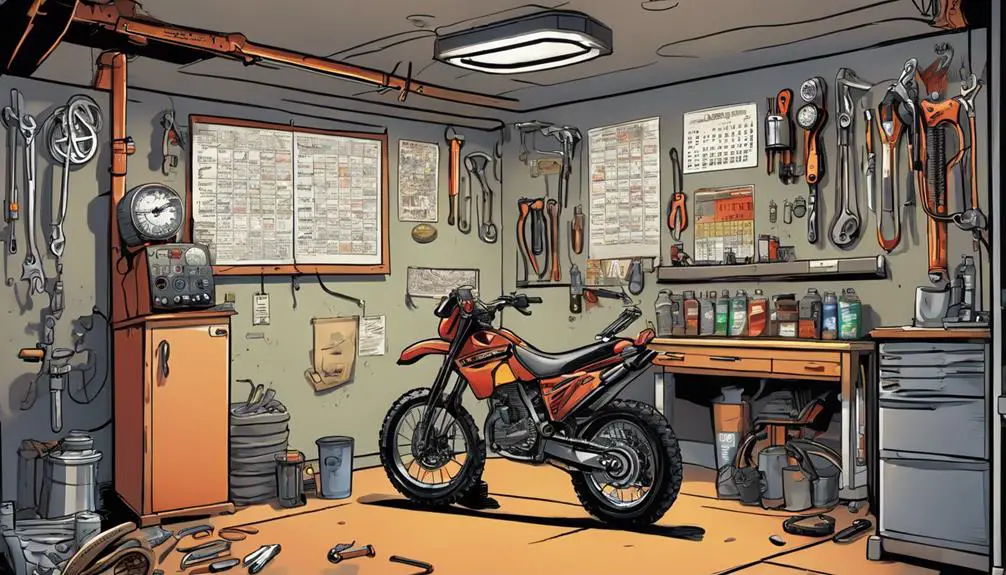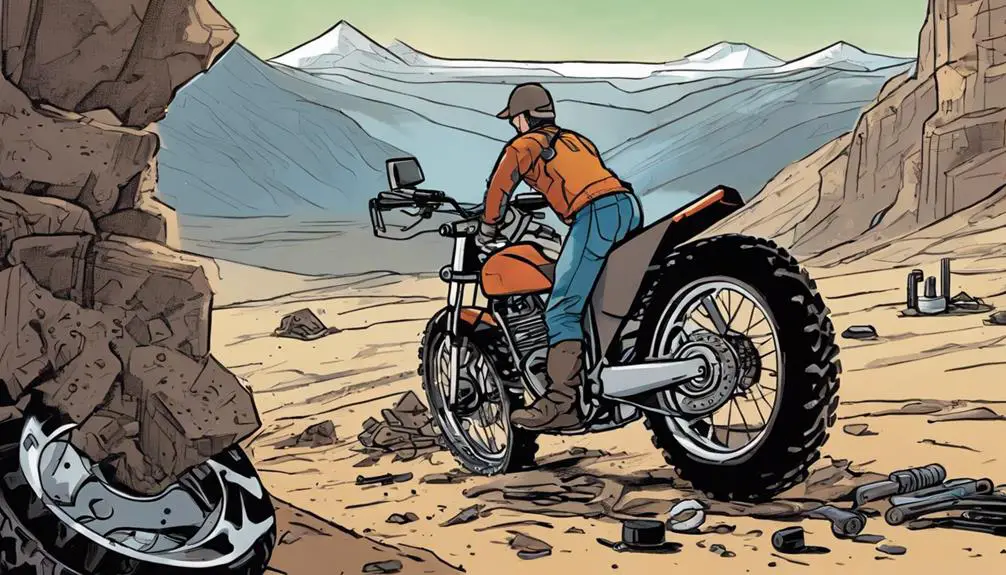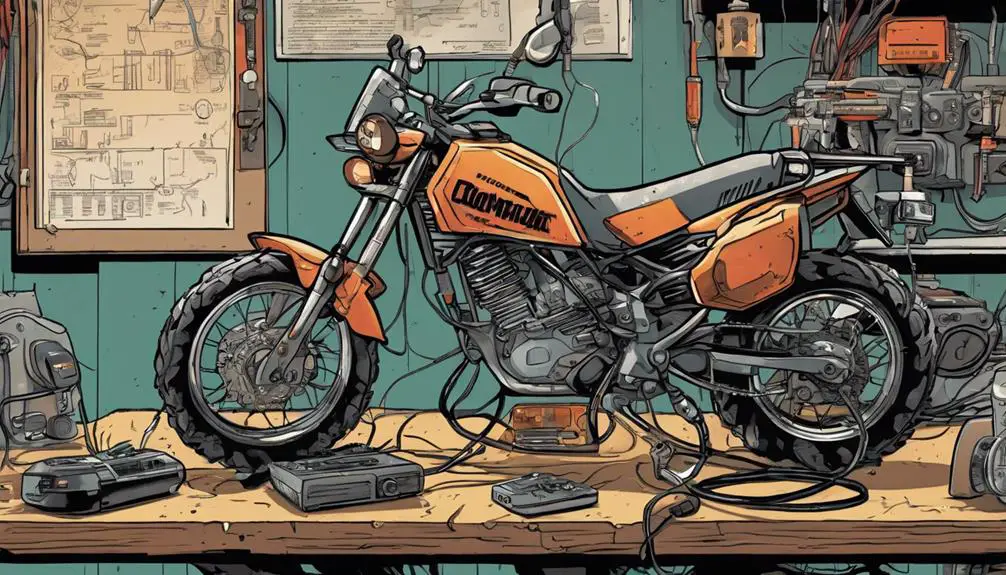When it comes to keeping your dual-sport bike in top condition, a few key practices can make all the difference. You might think routine check-ups and maintenance are just tedious chores, but they're crucial for ensuring your bike's reliability on any terrain. From monitoring tire pressure to performing electrical system checks, each aspect plays a critical role. Curious about how these tips can extend your bike's lifespan and enhance your riding experience? Let's explore the seven best strategies that every dual-sport rider should know.
Quick Takeaways
- Regularly check and clean the air filter to maintain optimal engine performance and efficiency.
- Inspect chain tension and lubrication frequently to ensure efficient power transfer and prevent wear.
- Maintain proper tire pressure to enhance grip, handling, and overall riding safety.
- Use high-quality oil and fluids tailored for dual-sport bikes to ensure engine longevity and performance.
Regular Maintenance Schedule

Regularly following a maintenance schedule is essential for keeping your dual-sport bike running smoothly. You value freedom, and nothing curtails that more than a breakdown. By committing to a routine, you're not just prolonging your bike's life; you're enhancing your adventures.
Start by checking your air filter and cleaning it every few rides. A clean filter guarantees your engine breathes well, optimizing performance.
Next, inspect your chain; it should be clean and properly lubricated. A well-maintained chain means efficient power transfer, allowing you to tackle any terrain with confidence.
Don't overlook tire pressure, either. Properly inflated tires improve grip and handling, giving you the freedom to navigate diverse landscapes.
Quality Oil and Fluids
Using high-quality oil and fluids is essential for maintaining your dual-sport bike's performance and longevity.
It's not just about keeping the engine running; it's about releasing the full potential of your ride. When you choose superior oil, you're ensuring ideal lubrication, reducing friction, and preventing wear and tear on critical components. This means fewer breakdowns and more freedom on the trails.
Don't settle for generic fluids. Look for products specifically designed for dual-sport bikes, as they can withstand the unique demands of both on-road and off-road conditions. Check the manufacturer's recommendations for oil viscosity and type, ensuring you're feeding your bike exactly what it needs.
Regularly changing your oil and filters keeps your engine clean and efficient. This simple step can drastically improve your bike's performance and your overall riding experience.
Also, pay attention to other fluids like brake fluid and coolant. Using high-quality options here enhances safety and reliability, ensuring your bike responds when you need it most.
In the world of dual-sport riding, your bike is your freedom. Protect it with the best oils and fluids, and it'll reward you with countless adventures.
Tire Inspection Practices

Tire inspections are essential for ensuring your dual-sport bike handles safely and performs at its best on any terrain.
Regularly check your tire pressure before each ride. Under-inflated tires can lead to poor handling and increased wear, while over-inflated tires can cause a harsh ride. Use a reliable gauge to maintain the manufacturer's recommended pressure, and don't forget to adjust for temperature changes.
Next, inspect the tread depth and pattern. Uneven wear can signal alignment issues or improper tire pressure. If you see less than 2/32 of an inch of tread, it's time to replace the tires.
Also, look for visible signs of damage, like cuts, bulges, or punctures. These could compromise your safety, especially on rugged trails.
Proper Chain Care
To keep your dual-sport bike running smoothly, proper chain care is essential for peak performance and longevity.
Start by regularly checking your chain tension. A well-tensioned chain guarantees efficient power transfer and prevents excess wear. If it's too loose, it can slip; too tight, and it'll strain your bike's components.
Next, clean your chain often. Dust, dirt, and grime can build up, leading to corrosion and reduced efficiency. Use a chain cleaner or a simple degreaser and a brush to scrub away the muck. Rinse it off and let it dry before moving on to lubrication.
After cleaning, apply a high-quality chain lubricant. This'll keep it running smoothly while protecting it from rust and wear. Remember to wipe off any excess lube to prevent attracting more dirt.
Lastly, inspect your chain for any signs of wear. Look for stiff links or noticeable elongation. If you notice any issues, it might be time to replace it.
Prioritizing these simple chain care routines not only enhances your ride but also gives you the freedom to explore without worries. So, keep that chain in check, and hit the road with confidence!
Electrical System Checks

Confirming your dual-sport bike's electrical system is in top condition is fundamental for reliable performance on any adventure.
Start by checking your battery. Make sure it's fully charged and free from corrosion; a clean connection can make a world of difference. If you notice any signs of wear, replace the battery before it leaves you stranded.
Next, inspect your wiring harness for frays or cuts. Damaged wires can lead to shorts and unexpected failures, so it's important to fix any issues before they escalate.
Also, examine your fuses; a blown fuse can cut off power to critical systems, so keep a few spares in your toolkit.
Don't forget about your lights and indicators. Verify all bulbs are functioning properly, as visibility is paramount on the road.
Regularly test your horn too; it's a significant safety feature.
Suspension Adjustments
After checking your electrical system, it's time to focus on suspension adjustments, which play an essential role in your bike's handling and comfort on various terrains.
Start by understanding your bike's suspension setup. Adjust the preload to match your weight and riding style. If you're planning on tackling rugged trails, increasing the preload can help prevent bottoming out.
Next, consider the compression and rebound settings. For off-road rides, you'll want a softer compression to absorb those bumps, while a quicker rebound can keep your wheels in contact with the ground, enhancing traction. On the other hand, if you're hitting the highway, firming up the compression might give you better stability.
Don't forget to test your adjustments! Take your bike for a spin on different surfaces, paying attention to how it responds. Fine-tuning these settings will make a world of difference in your riding experience.
Storage and Protection Tips

Properly storing your dual-sport bike can greatly extend its lifespan and performance, especially when you're not hitting the trails. Taking a few simple steps guarantees your ride remains ready for adventure whenever you are.
First, find a cool, dry place to store your bike. Avoid direct sunlight and moisture, as they can damage the paint and components. Use a bike cover to protect against dust and potential scratches.
Here are some essential storage tips:
- Maintain tire pressure: Keeping your tires inflated prevents flat spots and maintains their shape.
- Disconnect the battery: If your bike has an electric start, disconnect the battery to keep it from draining.
- Change the oil: Fresh oil reduces the risk of engine damage during long periods of inactivity.
Common Questions
How Often Should I Replace My Bike's Air Filter?
You should replace your bike's air filter every 5,000 to 10,000 miles, depending on your riding conditions.
If you ride in dusty or off-road environments, consider checking it more frequently.
A clean air filter guarantees your engine breathes better, enhancing performance and fuel efficiency.
Don't wait until it's clogged; keeping it fresh allows you to release the full potential of your ride, giving you the freedom to explore without limitations.
What Should I Do if My Bike Stalls Unexpectedly?
When your bike stalls unexpectedly, it can feel like hitting a brick wall.
First, don't panic; check for fuel and verify the kill switch isn't engaged.
Look for any visible issues, like loose connections or leaks.
If everything seems fine, let it cool down for a moment before restarting.
If it stalls again, you might want to inspect the spark plug or consult a mechanic to get back on the road to freedom!
How Can I Improve Fuel Efficiency on My Dual-Sport Bike?
To improve fuel efficiency on your dual-sport bike, start by keeping your tires properly inflated and maintaining a steady speed.
Avoid excessive idling, and consider using higher gears when possible.
Regularly clean or replace air filters, and guarantee your bike's engine is well-tuned.
If you can, shed any unnecessary weight to make your ride lighter.
These simple steps not only boost your mileage but also enhance your overall riding experience, giving you more freedom on the road.
What Are the Signs of a Failing Clutch?
When your clutch starts to fade, it's like a bird trying to fly with a broken wing.
You'll notice slipping gears, a spongy feel, or even difficulty shifting.
If you hear strange noises when you pull the lever, that's a red flag.
Don't ignore these signs!
Addressing clutch issues early can keep you free on the road, ensuring your ride remains smooth and exhilarating, just like the wind in your hair.
Should I Modify My Bike for Off-Road Performance?
If you're considering modifying your bike for off-road performance, think about what you want to achieve.
Upgrades like better suspension or knobby tires can enhance your ride, giving you the freedom to tackle rough terrains.
However, keep in mind that these changes might affect your bike's street performance.
Weigh the benefits against potential drawbacks, and choose modifications that align with your riding style and the adventures you crave.
Wrapping Up
By following these seven tips, you can markedly enhance your dual-sport bike's reliability and performance.
Did you know that regular maintenance can extend your bike's lifespan by up to 50%? Neglecting these simple tasks can lead to costly repairs down the line.
So, keep that air filter clean, check your tire pressure, and pay attention to your chain and suspension.
With a little effort, you'll enjoy countless adventures on your bike for years to come.